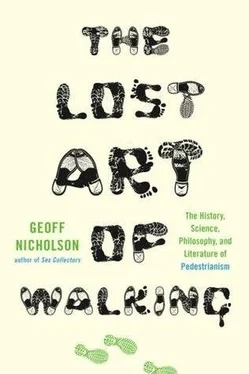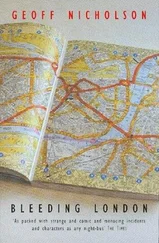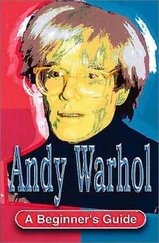For now I continue to walk constantly, mostly in Los Angeles because that’s where I live most of the time, but I also walk wherever else I am. Walking continues to be a great pleasure. It also continues to be a form of self-medication. It stops me from getting depressed. It keeps me more or less healthy, more or less sane. It helps me to write.
And so far I’ve managed to remain upright as I walk. Like anyone else I’ve occasionally tripped or slipped, lost my footing for a moment here and there, but so far I haven’t fallen down again, not since that day when I was walking in the Hollywood Hills and broke my arm in three places. This is a small achievement but a real and welcome one.
Walking is not a risk-free activity, and we probably don’t want it to be. We may fall down along the way. Something may get broken. People get lost, people walk into oblivion, some willingly, some not. Some return to tell lies about where they’ve been and what they’ve done — they create myths for themselves and others. This may not be strictly a good thing, but it’s hard to see how it can be prevented. For many of us the perfect walk may simply be the one that we come back from in one piece. For a writer the perfect walk may simply be one he can write about.
Perhaps also, in both writing and walking, each word, each step takes you a little nearer to the end of things, to the last sentence, the last walk. Sooner or later everybody takes their last step. However, because walking is able to make us healthier, happier, slightly fitter, certain steps in fact take us just a little further away from the end, at least for a while.
Abibliography of a thousand volumes begins with a single citation. But who would want a bibliography of a thousand volumes? I’ve therefore limited this list to items that are actually discussed in the text, or that I’ve genuinely used in writing the book. Literary works mentioned in passing, Ulysses, Swann’s Way , or Lessness , for example, are omitted, and their bibliographical details are surely easy enough to find elsewhere.
I’d been planning to write something on the subject of walking for a very long time. And then, in 2000, Rebecca Solnit published the book Wanderlust , subtitled ‘A History of Walking’, which got attention and good reviews, and which I approached reluctantly, afraid that the author might have said everything I wanted to say. Fortunately, and not so surprisingly, she didn’t. The book contains, for instance, a chapter called ‘Aerobic Sisyphus and the Suburbanized Psyche’, which made me tend to believe we weren’t on precisely the same walking path.
Then, in 2004, Joseph Amato published a book called On Foot , also, incredibly, subtitled ‘A History of Walking’, which again didn’t feel like direct competition. It has a chapter called ‘Choose Your Steps — Reflections on the Transformation of Walking from Necessity to Choice’.
Neither the Solnit book nor the Amato book contains a bibliography as such, but each has an extensive notes section: twenty-five pages in the case of Solnit, forty pages in the case of Amato. Amato says in his notes that Solnit’s book ‘proved useful’ to him. There’s obviously a serious temptation to strew footnotes all over a text about walking, but as you can see, I resisted.
♦
I’m aware of two texts called ‘The Art of Walking’. One is a short piece by Christopher Morley in the 1918 collection Shandygaff , subtitled ‘A number of most agreeable Inquirendoes upon Life & Letters, interspersed with Short Stories & Skits, the whole most Diverting to the Reader’. Morley writes:
‘Now your true walker is mightily curious in the world’, and he goes upon his way zealous to sate himself with a thousand quaintnesses. When he writes a book he fills it full of food, drink, tobacco, the scent of sawmills on sunny afternoons, and arrivals at inns late at night.’
The other is an anthology titled The Art of Walking , actually rather slender, edited by Edwin Valentine Mitchell, and published in 1934. It contains works by many of the usual suspects — Dickens, Leslie Stephen’s ‘In Praise of Walking’, Max Beerbohm’s ‘Going Out for a Walk’, as well as a piece by Christopher Morley called ‘Sauntering’. Thus:
‘It is entrancing to walk…and catalogue all that may be seen. I jot down on scraps of paper a list of all the shops on a side street; the names of tradesmen that amuse me — the absurd repartee of gutter children. Why? Because it amuses me and that is sufficient excuse’.
It’s interesting to compare the contents of that anthology with those of a more recent one, The Vintage Book of Walking , edited by Duncan Minshull, published in 2004. Dickens, Stephen, Beerbohm all hold their places, though there’s no room for poor old Morley. It seems that even in the world of walking, of walking anthologies and walking bibliographies, there are no such things as eternal verites.
Abbey, Edward. Desert Solitaire: A Season in the Wilderness . New York: McGraw-Hill, 1968.
— The Journey Home: Some Words in Defense of the American West . New York: Dutton, 1977.
Ainslie, Scott, and Dave Whitehill. Robert Johnson: At the Crossroads — the Authoritative Guitar Transcriptions . Milwaukee: Hal Leonard Publishing, 1992.
Alstruther, Stephen. The Mindful Hiker: On the Trail to Find the Path . Camarillo, Calif.: DeVorss Publications, 2004.
Amato, Joseph A. OH Foot: A History of Walking . New York: New York University Press, 2004.
Arturian, Judy, and Mike Oldham. Movie Star Homes: The Famous to the Forgotten . Santa Monica, Calif.: Santa Monica Press, 2004.
Asian, Reza. No God But God . New York: Random House, 2005.
Atget, Eugene. Atget Paris . Carte Madera, Calif.: Gingko Press, 1992.
Auster, Paul. The New York Trilogy . New York: Penguin, 1987.
Banham, Peter Reyner. Scenes in America Deserta . Salt Lake City: Gibbs Smith, 1982.
— Los Angeles: The Architecture of Four Ecologies . Harmondsworth, England: Allen Lane, Penguin Press, 1971.
Baudrillard, Jean. America . Translated by Chris Turner. London: Verso, 1988.
Bean, J.P. The Sheffield Gang Wars . Sheffield, England: D and D, 1981.
Bein, Alex. The Jewish Question: Biography of a World Problem . Translated by Harry Zohn. Rutherford, N.J.: Fairleigh Dickinson University Press, 1990.
Bellos, David. Georges Perec, A Life in Words . London: Harvill Press, 1993.
Benjamin, Walter. ‘The Flaneur’ (1938). In Charles Baudelaire, A Lyric Poet in the Era of High Capitalism . Translated by Harry Zohn and Quintin Hoare. London: NLB, 1973.
— The Arcades Project . Translated by Howard Eiland and Kevin McLaughlin. Cambridge, Mass.: Belknap Press, Harvard University Press, 1999.
Bradbury, Ray. ‘The Pedestrian’ (1951). In Sis for Space . London: Hart-Davis, 1968.
Brinnin, John Malcolm. Dylan Thomas in America: An Intimate Journal . London: Dent, 1956.
Brook, Stephen. L.A. Lore . London: Sinclair-Stevenson, 1992.
Brownlow, Kevin. ‘Brownlow on Beckett (on Keaton)’. In Film West 22, Autumn 1995.
Burton, Richard. Personal Narrative of a Pilgrimage to El-Medinah and Meccah , 3 vols. London: Longman, Brown, Green and Longmans, 1855-57.
Burton, Robert. The Anatomy of Melancholy (1621). New York: New York Review of Books, 2001.
Campbell, Ffyona. Feet of Clay: Her Epic Walk Across Australia . London: Heine-mann, 1991.
— On Foot Through Africa . London: Orion, 1994.
Читать дальше












